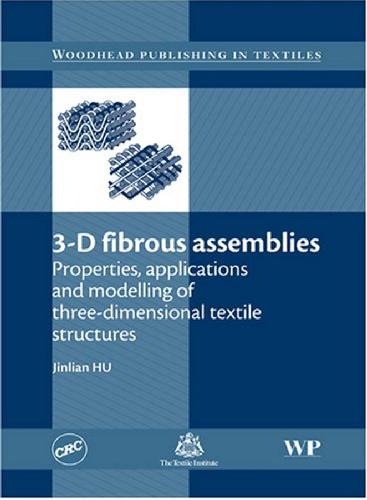Jinlian Hu,Textile Institute (Manchester, England)9781845694982, 1845694988
Table of contents :
Cover Page
……Page 1
Title Page
……Page 2
3-D fibrous assemblies: Properties, applications and modelling of three-dimensional textile structures……Page 4
Contents……Page 6
Woodhead Publishing in Textiles……Page 9
Preface……Page 14
Acknowledgements……Page 17
1.1 Introduction: concepts of three-dimensional fibrous assemblies……Page 18
1.2.1 Two-dimensional wovens……Page 19
Triaxial woven fabrics……Page 20
Warp-knitted fabric……Page 21
1.2.3 Two-dimensional non-wovens……Page 22
1.2.4 Two-dimensional braids……Page 23
1.3 Limitations of two-dimensional textile structures……Page 24
1.4.1 Definition of three-dimensional fibrous assemblies……Page 25
1.4.3 Three-dimensional woven fabrics……Page 26
Classification of three-dimensional woven fabrics……Page 27
Advantages of three-dimensional woven structures……Page 33
1.4.4 Three-dimensional knitted fabrics……Page 34
1.4.5 Three-dimensional braided fabrics……Page 36
Principle of three-dimensional braiding……Page 37
Advantages of three-dimensional braided structures……Page 38
1.4.6 Three-dimensional stitched fabrics……Page 39
Stitch-bonded multi-plies……Page 40
1.4.7 Three-dimensional non-woven fabrics……Page 42
1.5 Conclusions……Page 47
1.6 References……Page 48
2.1 Introduction……Page 50
2.2 Application of three-dimensional fabrics to composites……Page 51
2.2.1 Classification of textile preforms……Page 52
2.2.2 Processing of textile composites……Page 54
2.2.3 Three-dimensional woven fabrics……Page 58
2.2.4 Three-dimensional braided fabrics……Page 62
2.2.5 Three-dimensional knitted fabrics……Page 65
2.2.6 Three-dimensional non-woven fabrics……Page 66
2.3 Application of three-dimensional fabrics to medical textiles……Page 67
2.4 Application of three-dimensional fabrics to sports……Page 70
2.5 Application of three-dimensional fabrics to geotextiles……Page 73
2.6 Application of three-dimensional fabrics to automotives……Page 77
2.7 Application of three-dimensional fabrics to protective clothing and the aerospace industry……Page 79
2.8 References……Page 83
3.1 Introduction to multiaxial warp-knitted fabrics……Page 87
3.2 Advantages of multiaxial warp-knitted fabrics……Page 89
3.3 Manufacture of multiaxial warp-knitted fabrics……Page 90
3.3.1 The LIBA technique……Page 92
3.3.2 The Mayer technique……Page 94
3.4.1 Structure……Page 98
Unit cell geometry……Page 101
3.4.2 Mechanical behaviour……Page 104
Shear behaviour……Page 106
Compression……Page 107
Flexural behaviour……Page 108
Tearing behaviour……Page 110
3.5 Applications of multiaxial warp-knitted fabrics……Page 114
3.6 Summary……Page 117
3.7 References……Page 118
4.1 Introduction to multilayer woven fabrics……Page 121
4.2 Advantages of multilayer woven fabrics……Page 122
4.3 Manufacture of multilayer woven fabrics……Page 123
4.4.1 Structure……Page 130
Pattern design of three-dimensional multilayer woven fabrics……Page 131
Weave instruction in cross-sections of weft……Page 132
Tensile behaviour……Page 136
Shear behaviour……Page 139
Compressive behaviour……Page 143
4.5 Applications of multilayer woven fabrics……Page 144
4.6 Summary……Page 146
4.7 References……Page 147
5.1 Introduction……Page 148
5.2 Tensile behaviour of multiaxial warp-knitted fabrics……Page 149
5.3 Modelling tensile properties of multiaxial warp-knitted fabrics……Page 156
5.3.2 Basic assumptions and approximations……Page 158
Relationships between epsilon and epsiloni……Page 159
The stress–strain relationship of a multiaxial warp-knitted fabric under uniaxial stretch……Page 161
Formulation of the tensile modulus……Page 163
5.4 Experimental methods and validation……Page 164
5.4.1 Validation of the model……Page 165
5.5 Conclusions……Page 166
5.6 References……Page 168
6.1 Introduction……Page 170
6.2 Bending properties of multiaxial warp-knitted fabrics……Page 172
6.2.1 Results of experiments……Page 175
6.3 Bending hysteresis curves of multiaxial warp-knitted fabrics……Page 176
6.5 Effect of bending sequence on bending hysteresis curves……Page 179
6.6 Cyclic bending……Page 180
6.7 Modelling bending properties of multiaxial warp-knitted fabrics……Page 181
6.8 Model validation……Page 186
6.9 Conclusions……Page 188
6.10 References……Page 190
7.1 Introduction……Page 191
7.2.1 Prepreg flow mechanisms……Page 193
7.2.3 Micro-level fabric deformation modes……Page 194
7.3 Structure of multiaxial warp-knitted fabrics……Page 196
7.5 Deformation characteristics of multiaxial warp-knitted fabrics during the forming process……Page 197
7.6.1 Relative movement of two inserting yarn systems……Page 199
7.6.2 Roles of stitching loops on the deformation of two-bias multiaxial warp-knitted fabrics……Page 200
7.6.3 Hemisphere-pressing experiments……Page 201
7.6.4 Theoretical analysis……Page 202
7.7.1 Modelling the forming process of two-bias multiaxial warp-knitted fabrics……Page 205
7.7.2 Verification of the model……Page 206
7.8 Summary……Page 207
7.9 References……Page 209
8.1 Introduction……Page 211
8.2 Fabric compressibility……Page 217
8.3 Permeability testing……Page 218
8.3.1 Saturated vs. unsaturated flow……Page 219
8.3.2 Permeability as a function of weave type……Page 221
8.3.4 Isotropic and anisotropic permeability……Page 222
8.3.5 Measurement of permeability……Page 223
8.4.1 Characterization of pore microstructures……Page 224
8.4.2 Permeability model of unit cell 1……Page 225
8.4.3 Evaluation of Vf,max……Page 227
8.4.4 Predicted permeability of unit cell 1……Page 228
8.4.5 Permeability model of unit cell 2……Page 229
8.4.6 Permeability of whole structure……Page 230
8.5.1 Fractal characterization of pore microstructures in fibre preforms……Page 231
8.5.2 Fractal model for permeability……Page 232
8.6 Conclusions……Page 233
8.7 References……Page 234
9.1 Introduction……Page 238
9.2 Flow resistance of multilayer woven fabrics……Page 240
9.3 Flow modelling of multilayer woven fabrics……Page 242
9.4 Modelling flow and void formation……Page 245
9.4.1 Void formation in multilayer woven fabrics……Page 251
9.4.2 Experimental results……Page 253
9.5 Modelling the effect of stitch size, distribution and position……Page 254
9.5.1 The effect of stitch size on distribution density……Page 255
9.5.2 The effect of stitch size on permeability……Page 259
9.5.3 The effect of stitch off-centre position in channel……Page 261
9.5.4 The effect of stitch array……Page 264
9.6 Conclusions……Page 268
9.7 References……Page 269

Reviews
There are no reviews yet.